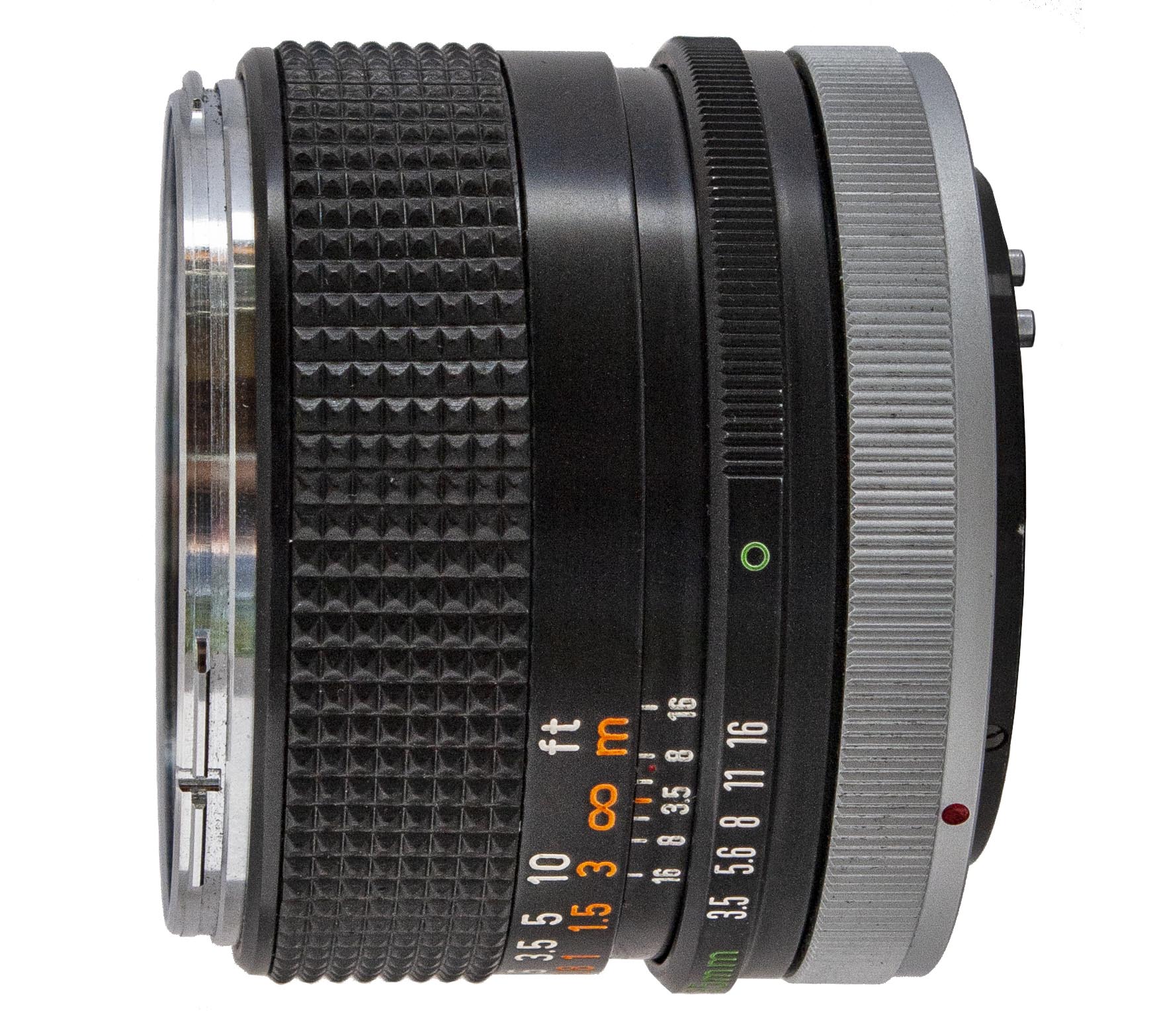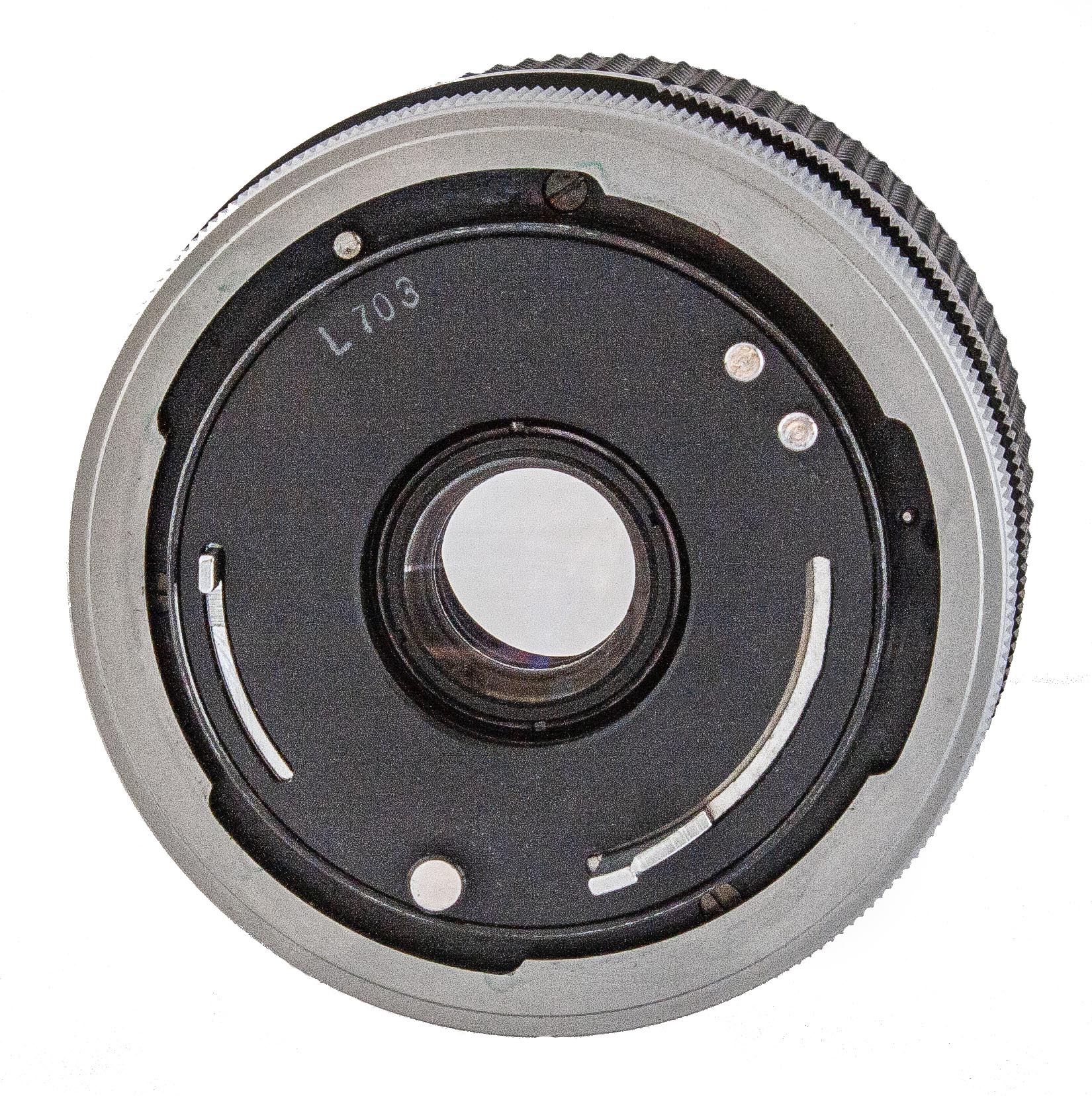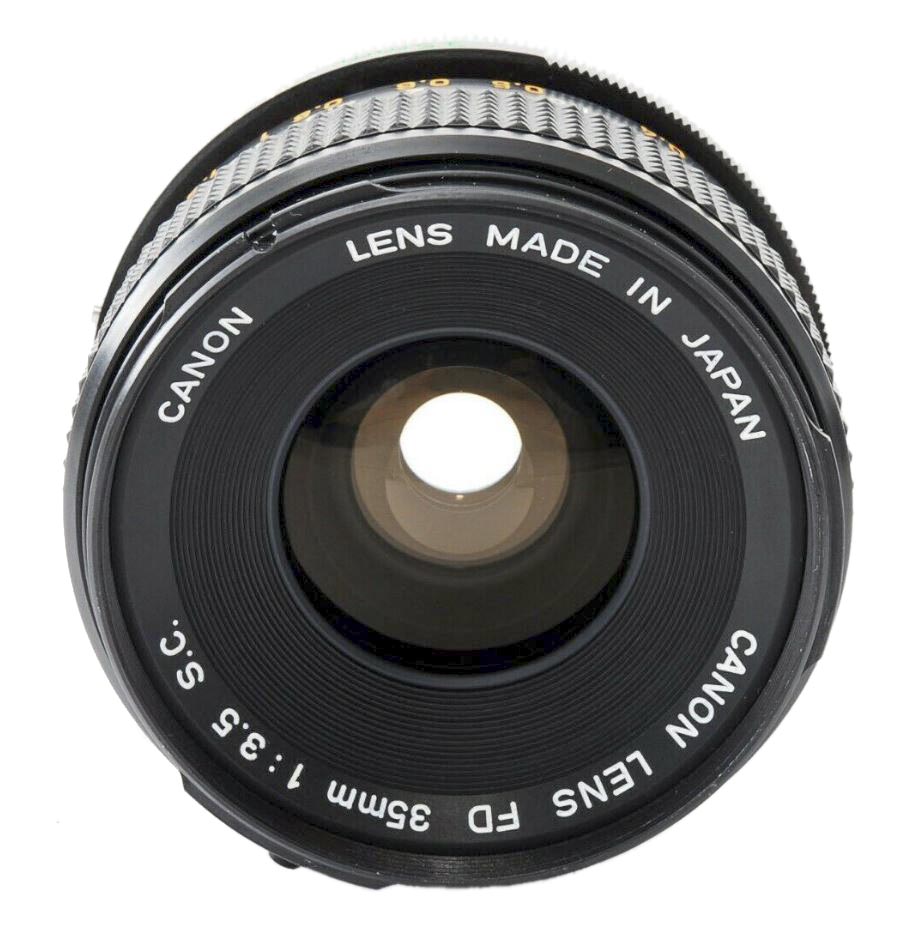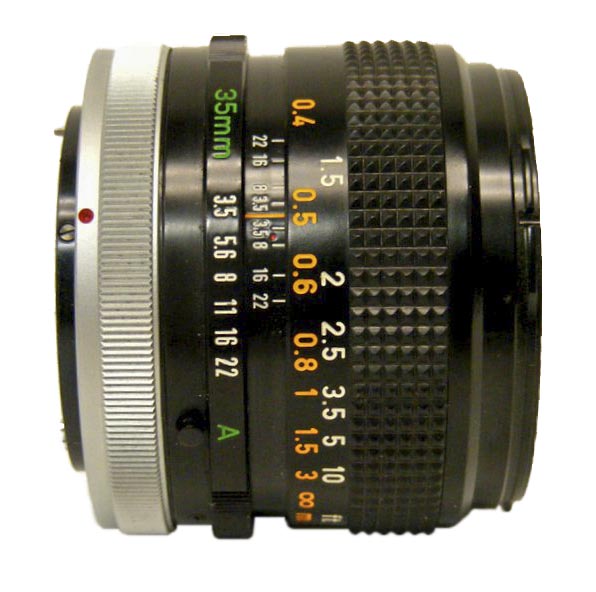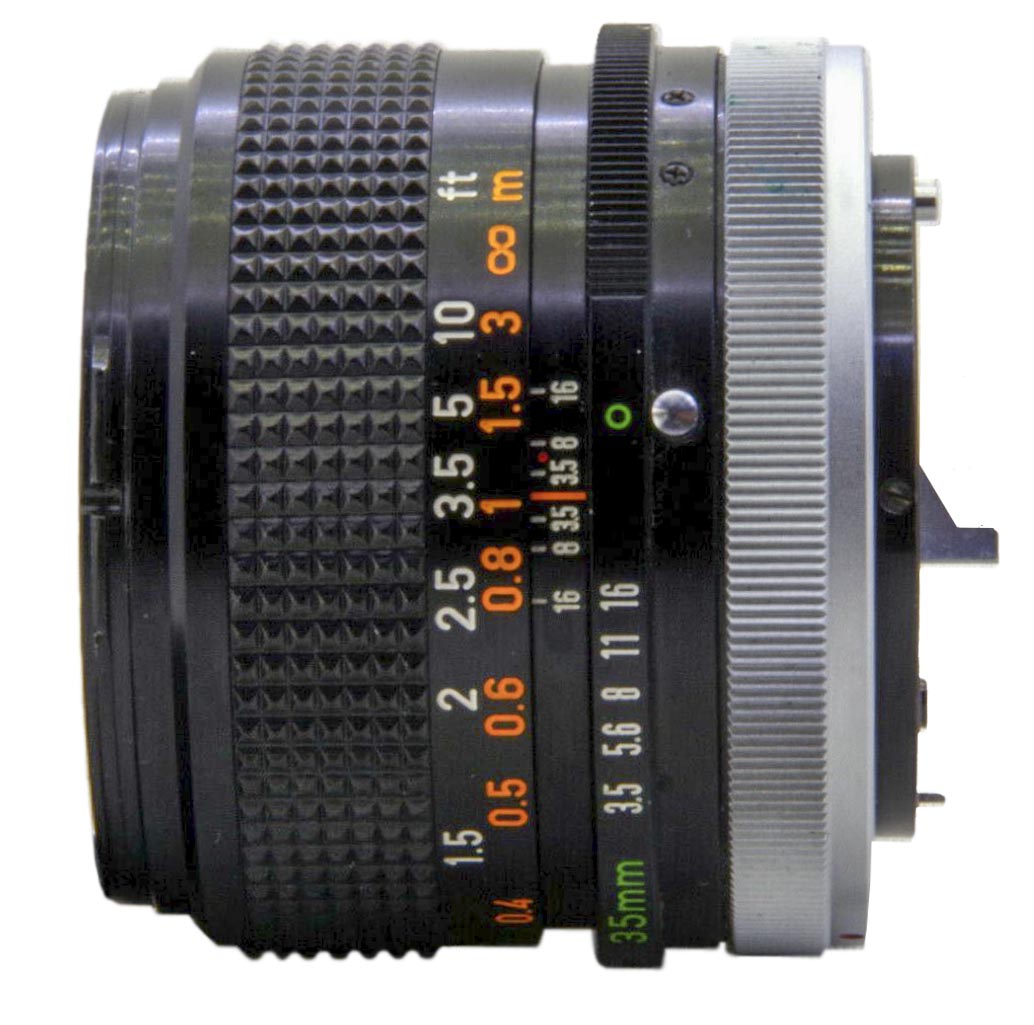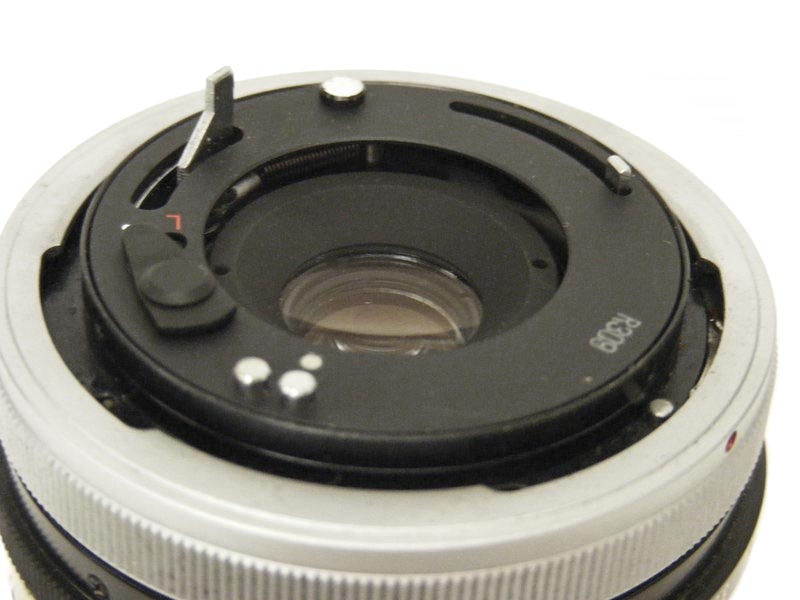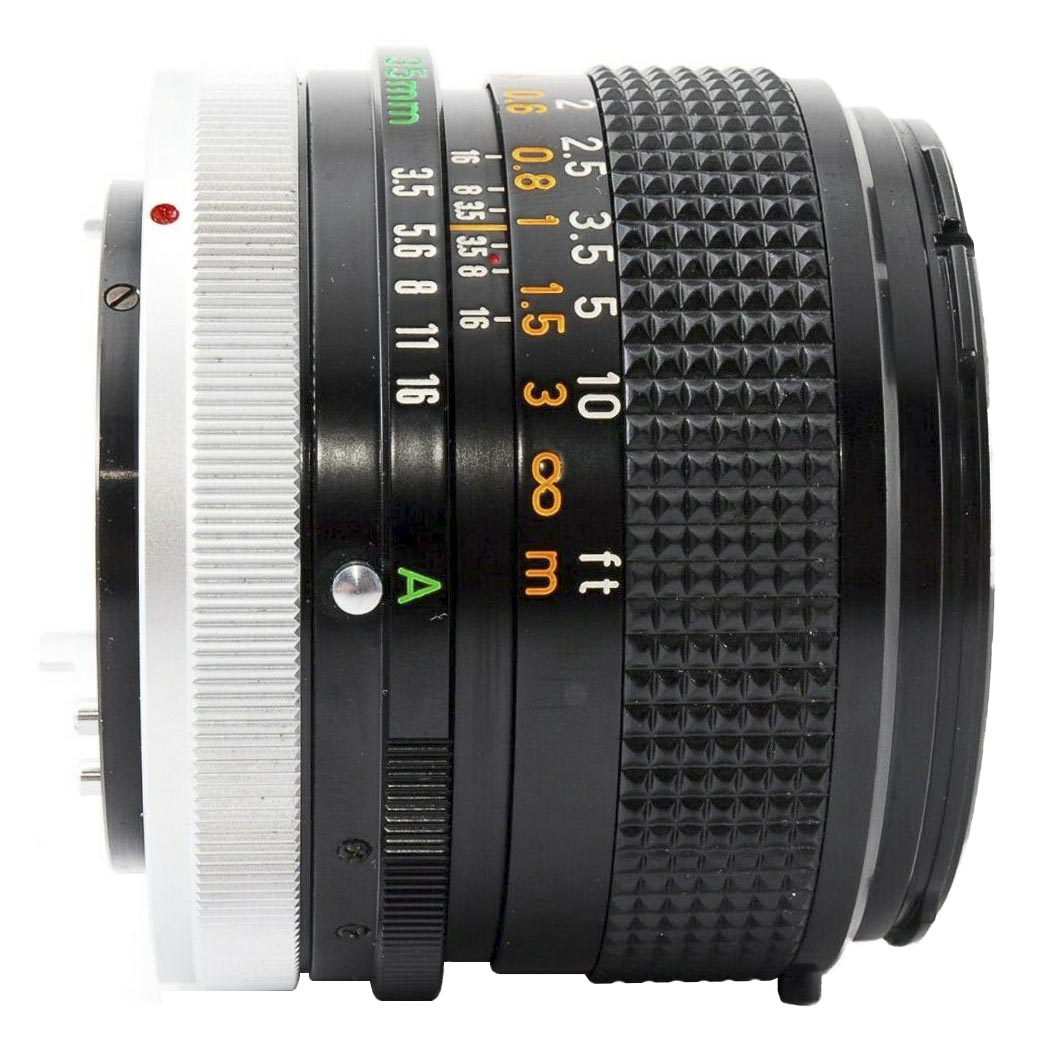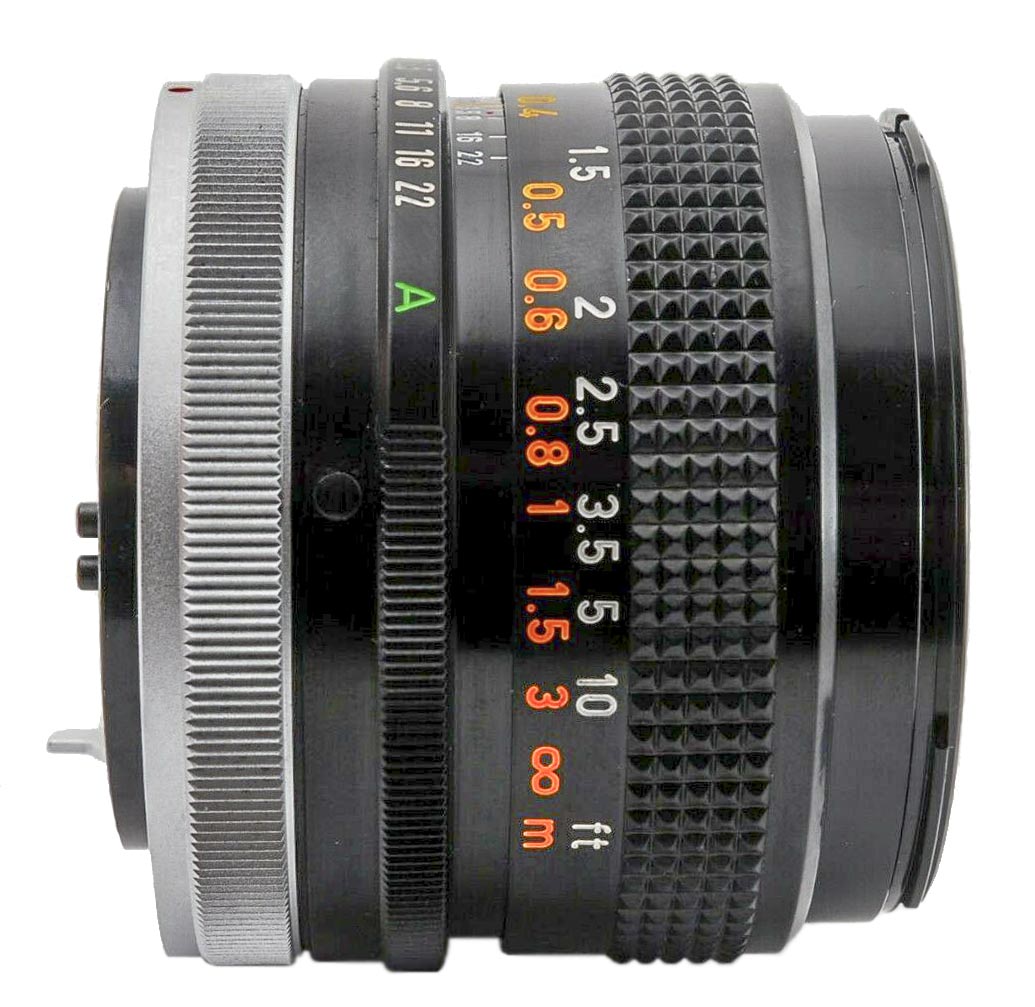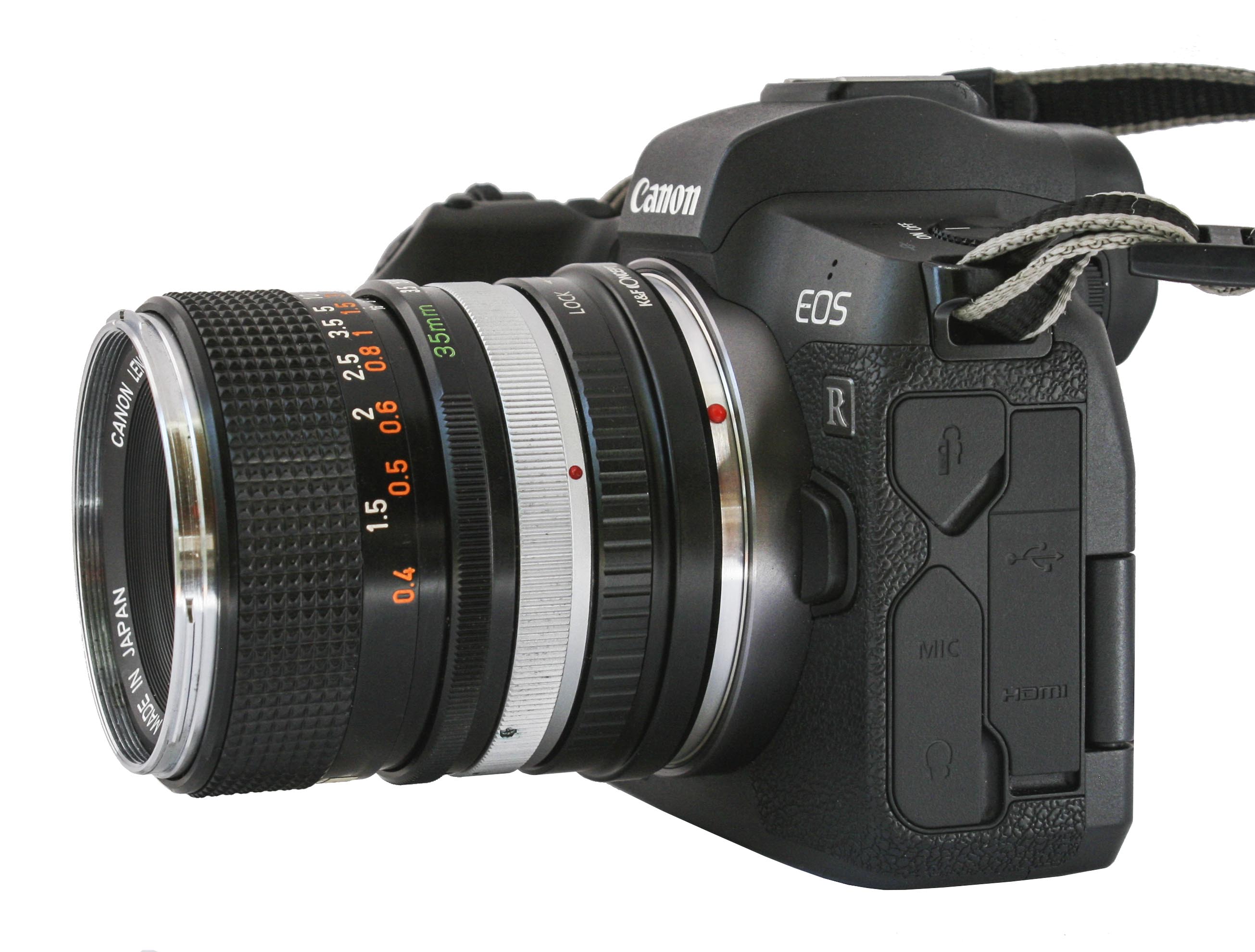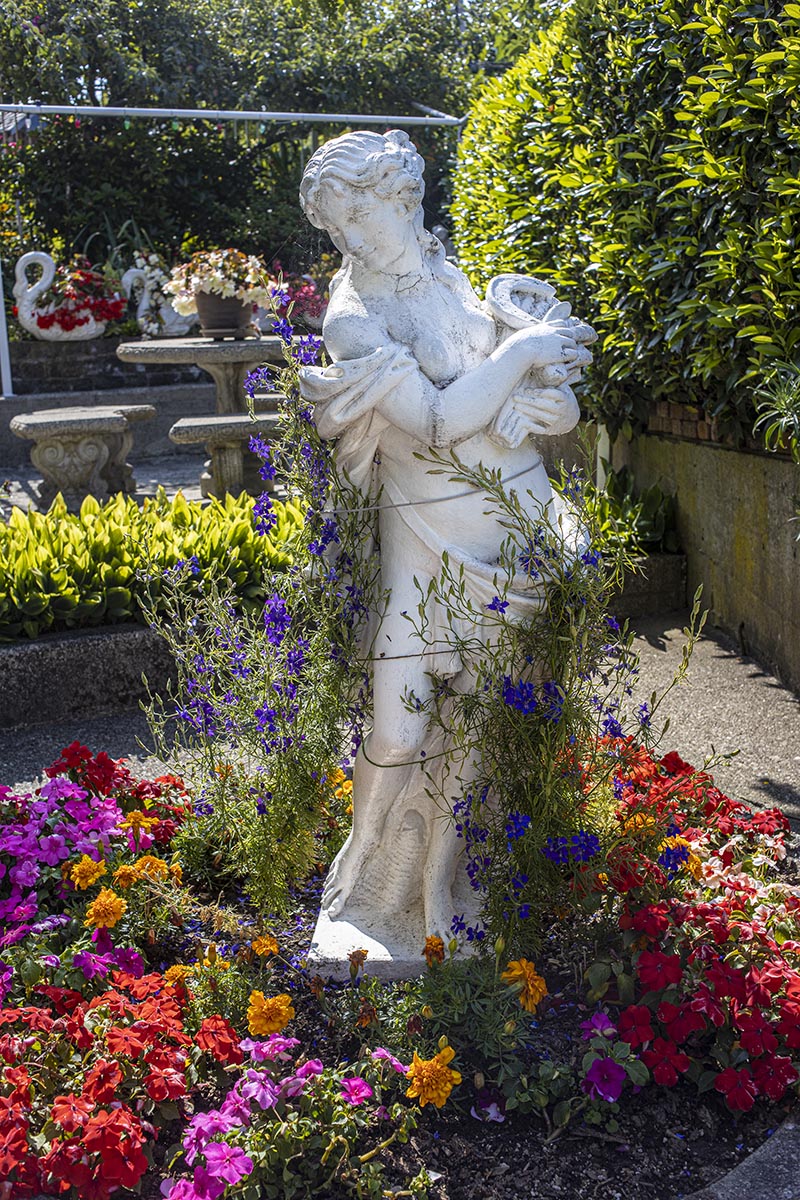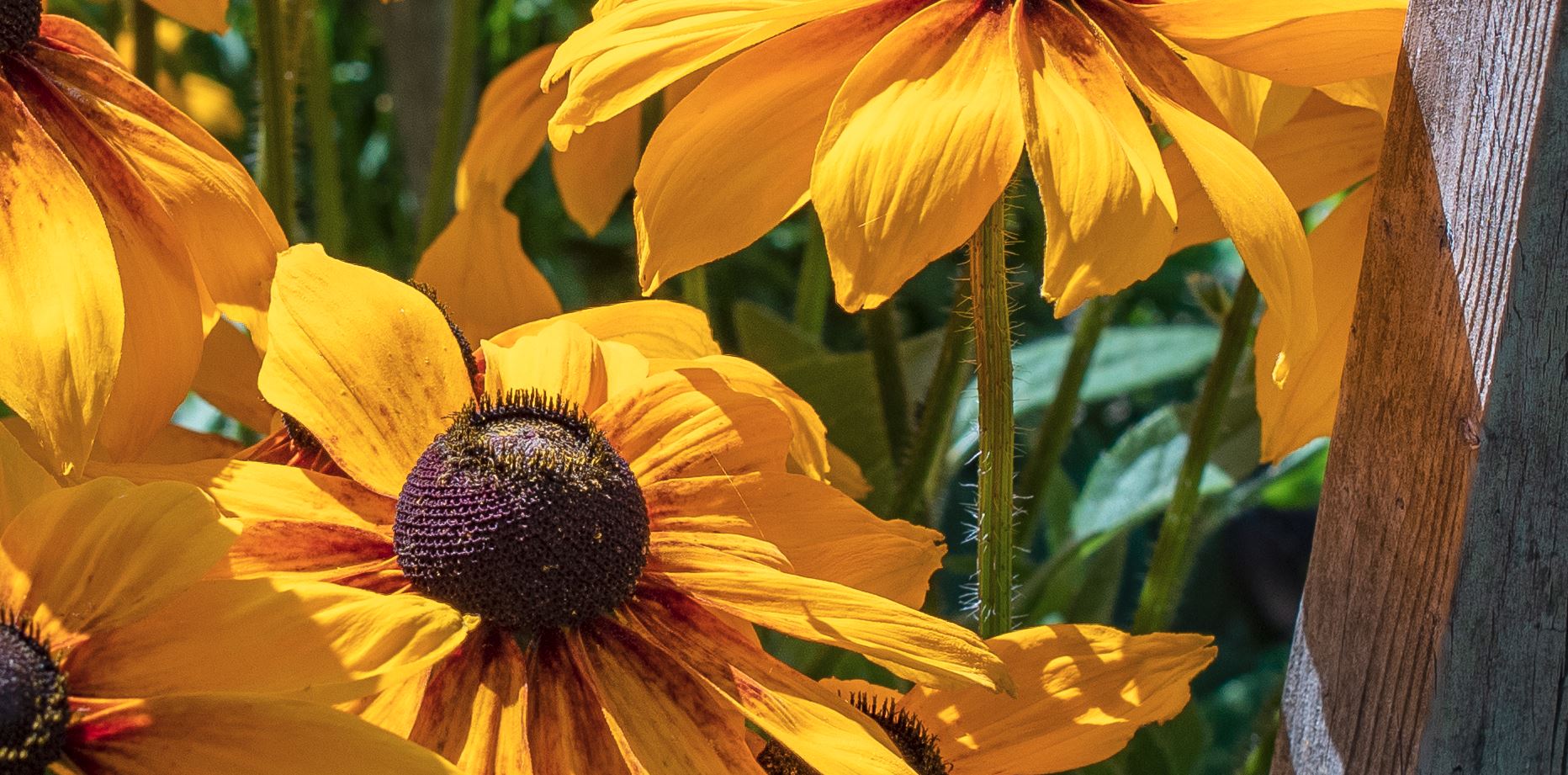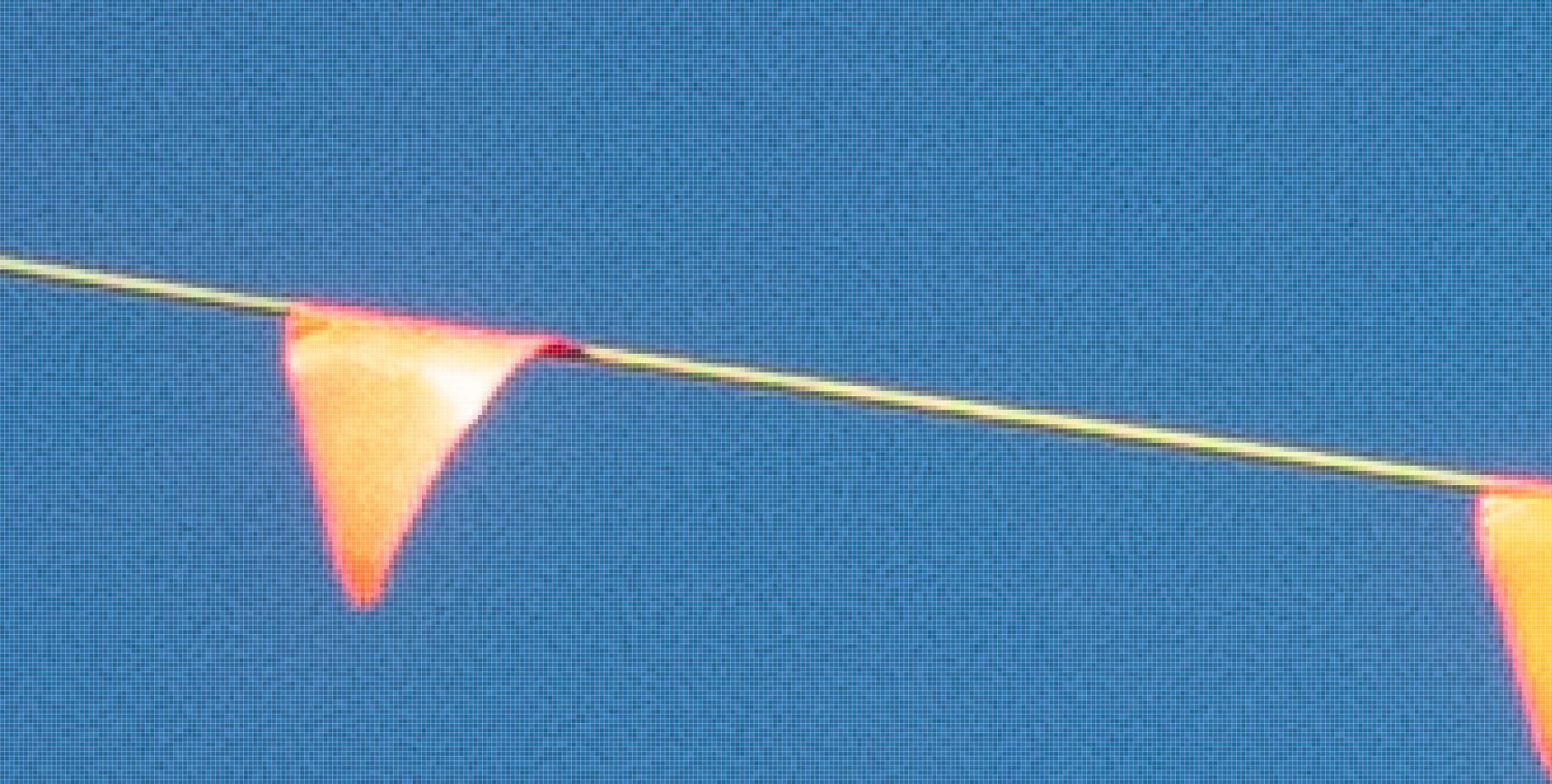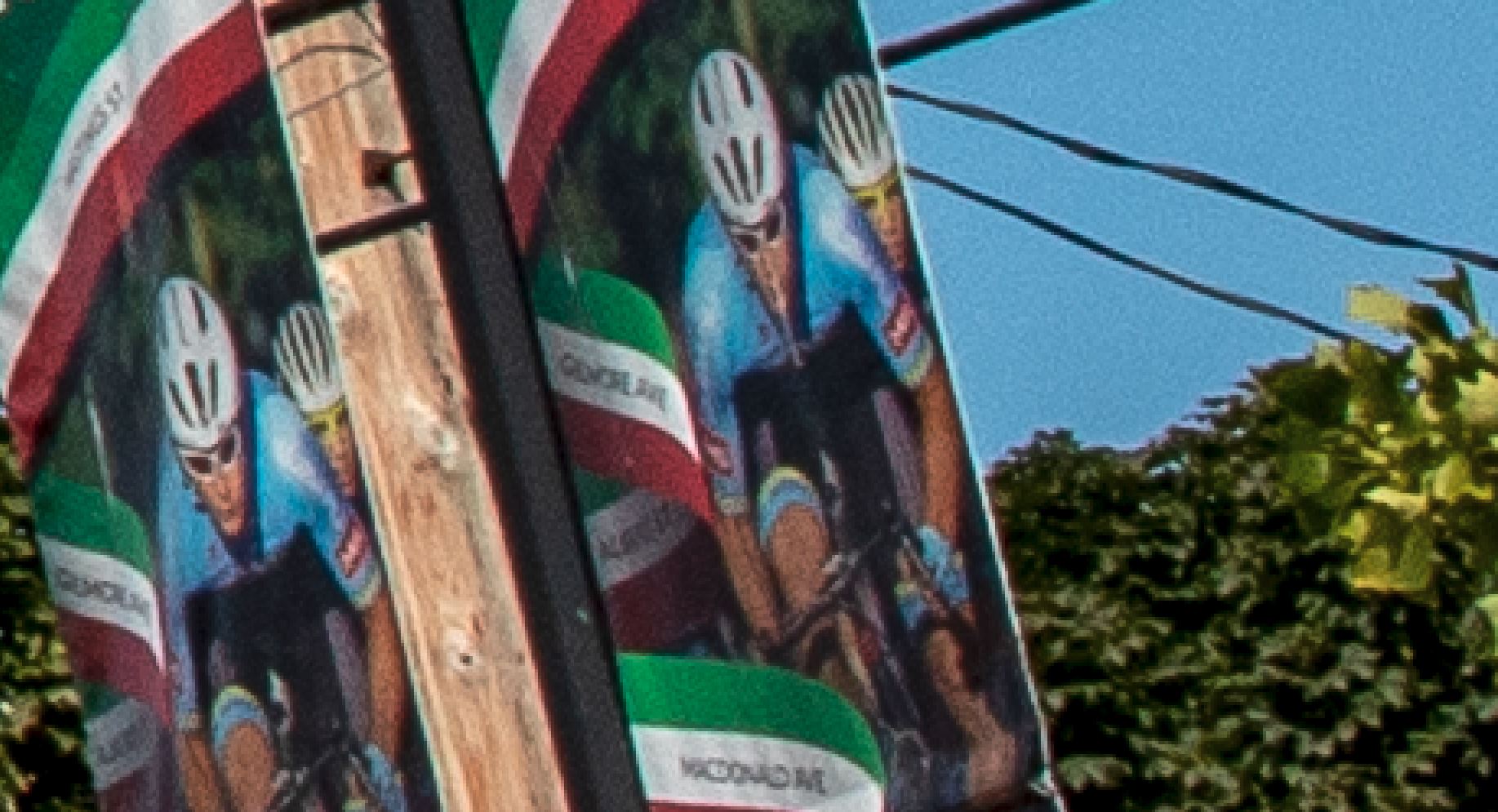This is the first of the FD 35mm f/3.5 lenses and the one I bought from Andrew. It has the distinctive “chrome nose” for the period. When I first looked in the Canon Museum for this lens I could not find it at first.
Of the four versions of this lens, this is the only one that does not have “S.C.” on the name ring after the name of the lens.
In this side view the Green “O” automatic mark is clearly visible. On the original F-1 turning this ring to the “O” setting would allow the camera to set the aperture automatically, i.e. operate in Shutter Priority mode. Note that there is no EE Lock Pin on this lens.
FD 35mm f/3.5
The other day, watching Craig’s list as I do, I found an FD 35mm f/3.5 for sale. As I did not have one of these I answered the ad and met Andrew who had a pristine “chrome nose” for sale. It was a little pricey but it was in wonderful condition so we made a deal and I got the lens. And then the fun began.
Going to the Canon Museum I found that Canon actually made 4 of these lenses in the 1970’s but the one in my hands was not listed there. So what did I have?
Looking carefully at what Canon had listed for the first lens, the FD 35mm f/3.5, the text said the minimum aperture was F/16 but the photo showed a lens that had f/22. The photo was obviously wrong.
So then I looked at the entry for the FD 35mm f/3.5mm (I). Same problem: the photograph was wrong. The photo for the FD 35mm f/3.5 (II) is also wrong. The Auto Setting Lock Pin is offset from the green “A” in the photo which is incorrect as we shall see. But looking at the photo for the FD 35mm f/3.5 (III) I see that it too is wrong. That photo is of the (II) version.
Then when I began searching the web I found that people are generally not understanding these lenses. They either don’t list them all or they describe them incorrectly. So the problem was to clarify the history of this lens and its identifying characteristics when I only had this one example in my hands. This is the joy of a hobby: there is always interesting stuff to do.
The date code on this lens, L703, tells us this lens was made in July of 1971. The Auto position, for use with the original F-1, is marked with a green “O” and there is no EE Lock Pin. The aperture ring could move easily from the manual aperture settings to the Auto setting simply by turning it.
Lens Characteristics Summary
Canon made four FD 35mm f/3.5 lenses. Although all of the pictures in the Canon Museum are incorrect we have to assume that the technical specifications are correct. When charted we get this table:
| Item | FD 35mm f/3.5 (Chrome Nose) | FD 35mm f/3.5 S.C. (I) | FD 35mm f/3.5 S.C. (iI) | FD 35mm f/3.5 S.C. (III) |
| Date of Issue | Mar ’71 | Mar 73 | Mar ’75 | July ’77 |
| Groups | 6 | 6 | 6 | 6 |
| Elements | 6 | 6 | 6 | 6 |
| Aperture Blades | 6 | 6 | 5 | 5 |
| Min. Aperture | f/16 | f/16 | f/22 | f/22 |
| Min. Focus (M) | .4 | .4 | .4 | .4 |
| Filter Thread | 55mm | 55mm | 55mm | 55mm |
| Weight (gr) | 325 gr | 295 gr | 236 gr | 236 gr |
Sorting Out the 35’s
One of the great resources we have for figuring out what lens we have in our hands is E-bay. Because sellers usually supply excellent photographs of the lenses they are selling we can examine the different lenses closely. I was able to find 13 examples of these lenses on which I could make out their date codes. Once I knew when they were made I was able to organize them by date and thus figure out how to tell them apart. I created the following chart which shows the process:
| Date | EE Lock Pin | Name Ring Name | Min. f/stop | Nose Color | Note |
| March 1971 – Intro of FD 35mm f/3.5 | |||||
| Jul 71 | O – no EE Lock Pin | FD 35mm 1:3.5 | f/16 | Chrome | No CAT Coupling Pin |
| Jun 72 | O – no EE Lock Pin | FD 35mm 1:3.5 | f/16 | Chrome | No CAT Coupling Pin |
| March 1973 – Intro of FD 35mm f/3.5 (I) | |||||
| Mar 73 | O – aligned w silver EE Lock Pin | FD 35mm 1:3.5 S.C. | f/16 | Black | CAT Coupling Pin |
| May 73 | O – aligned w silver EE Lock Pin | FD 35mm 1:3.5 S.C. | f/16 | Black | CAT Coupling Pin |
| Oct 73 | O – aligned w silver EE Lock Pin | FD 35mm 1:3.5 S.C. | f/16 | Black | CAT Coupling Pin |
| Jul 74 | O – aligned w silver EE Lock Pin | FD 35mm 1:3.5 S.C. | f/16 | Black | CAT Coupling Pin |
| Dec 74 | A – aligned w silver EE Lock Pin | FD 35mm 1:3.5 S.C. | f/16 | Black | CAT Coupling Pin |
| March 1975 – Intro of FD 35mm f/3.5 (II) | |||||
| Mar 77 | A – aligned w Black EE Lock Pin | FD 35mm 1:3.5 S.C. | f/22 | Black | Manual Aperture Lever, CAT Coupling Pin |
| July 1977 – Intro of FD 35mm f/3.5 (III) | |||||
| Aug 77 | A – offset from Black EE Lock Pin | FD 35mm 1:3.5 S.C. | f/22 | Black | CAT Coupling Pin |
| Feb 78 | A – offset from Black EE Lock Pin | FD 35mm 1:3.5 S.C. | f/22 | Black | CAT Coupling Pin |
| Mar 78 | A – offset from Black EE Lock Pin | FD 35mm 1:3.5 S.C. | f/22 | Black | CAT Coupling Pin |
So what can we learn from this table? Well, we already know that the first version, the FD 35mm f.3.4, is a “chrome nose”. It is the only one so that is an easy one to pick out. All of the other three have black noses and identical name rings. The name ring is visible in Photo #1.
From the chart we can see that the FD 35mm f/3.5 (I) is the only black nosed 35mm with a minimum aperture of f/16. The remaining 2 are f/22. So that is how we can distinguish it. See Photo #2. Also note that there is a silver pin for locking the automatic setting aligned with the green “O”. On the remaining two the pin is black. I did find one with a green “A” and a silver pin. See Photo #3.
There was only one FD 35mm f/3.5 (II) in the ones I examined. Two things distinguish it. The first is that the Auto Setting locking pin is now black and it is aligned with the green “A”. See photo #4 below. There is also a manual aperture lock lever on the back of the lens. See photo #5.
And finally, the FD 35mm f/3.5 (III). This lens can be identified by the fact that the black Auto Setting lock pin is offset from the green “A” as shown in Photo #6.
Photo #1 – The front of all of the FD 35mm f/3.5 S.C. (I), (II), and (III) are identical and no help in distinguishes these lenses one from the other. All have the S.C. coating and none have S.S.C.
Photo #4 – This is the FD 35mm f/3.5 S.C. (II) with the green “A” and a silver lock button aligned with each other.
Photo #2 – The FD 35mm f/3.5 (I) has the same green “O” as the Chrome Nose but has an added silver locking pin aligned with it. Minimum aperture is f/16 as you can see here.
Photo #5 – The back of the FD35mm f/3.5 S.C. (II) showing the manual aperture lock lever unique to this model.
Photo #3 – This is the FD 35mm f/3.5 (I): black nose and minimum f/16 aperture. Notice that it has a silver pin aligned with a green “A” and not an “O” as most of them do like Photo #2.
Photo #6 – Here we have the green “A” but the pin is offset about a half inch. On the S.C. (II) and (III) all pins are black.
And so, there we are: the FD 35mm f/3.5’s decoded. In summary, then, here is how to tell them apart:
| Name | Identifying Characteristics |
| FD 35mm f/3.5 | This is easy: it’s a “chrome nose”. |
| FD 35mm f/3.5 (I) | Only black nose with minimum aperture of f/16. Also has silver EE Lock Pin. |
| FD 35mm f/3.5 (II) | Minimum aperture of f/22 and black EE Lock Pin aligned with green “A”. |
| FD 35mm f/3.5 (III) | Minimum aperture of f/22 and black EE Lock Pin offset from the green “A” |
So How good is the FD 35mm f/3.5?
As I have said many times, I don’t do not do technical reviews of my equipment. I just want to know what the lenses can do and if I am happy with the performance. Spoiler alert: this is an amazing lens!
To test it I put it on my Canon R full frame camera and went for a walk. It is actually really easy to use this lens like this. From experience I know that an ISO of 200 will allow me to shoot, on a sunny day, at f/8.0 and still have a decent shutter speed. With the focus peaking feature in the camera manual focus, even for my old eyes, is easy. My FD to R adapter allows me to focus at full aperture and then easily stop down without taking my eye from the viewfinder. The pictures I took are not an attempt to make “art”. That said, let’s have a look.
This is one of my favorite test subjects; my Madonna dei Fiori. Susan always keeps her so nice. She has stood in our garden for many years and she is always changing. It is amusing, but every time I pass her, for years now, I talk to her. Lately she has been answering me. Getting old produces many wonders.
This image was shot at f/8.0 and I have done some post processing. I want to see what I can do with the lens and Photoshop is part of that process. The image on the left is the full frame with no cropping whatsoever.
Now look at the image below. Click on it to expand the view. Several things stand out. The lens is sharp! This is not the center of the image and yet it is excellent. The spider’s web and the blue flowers it is connected to are in wonderful detail. And remember, this was with manual focus.
Although I am shooting at f/8.0 the far background shows a lovely bokeh. I should have taken this wide open to really isolate the lady.
O.K. …. I admit it: I have a thing for my wife’s flowers. All flowers, really. I never tire of taking pictures of them and this image shows why. They have beautiful forms, wonderful color and they come in endless variety. Most of my flower pictures are little more than snapshots but they bring me pleasure.
But look at the detail on the left showing what this lens can do. This is a serious lens. My sensor is 30mp and yet this lens out performs the camera. And notice there is no apparent chromatic aberration. This lens was designed for film cameras and there is no film that could have captured all of this detail.
And now, before we’re done, one last picture. This is definitely not “art” but it has horizontal and vertical lines in contrasting colors that go edge to edge. This is perfect for pixel gazing, in the center, at the edge and in the corners. (Speaking of pixel gazing, and not related to anything in particular, I was in Las Vegas a few years ago and I wandered into Peter Lik’s gallery store to look at his images. I did my usual and stood ten inches from the prints with my reading glasses on to judge the pixels and thus the lens and camera. The lady that was curator that day came over to me and asked “What camera do you normally shoot with?” She knew I was a photographer and she told me that all the photographers who come in do exactly the same thing.) Anyway, here is the whole frame and below it details from the center, edge and corner.
At no particular magification, this is the center of the image and it is tight and sharp with no visible aberrations.
This is at the extreme left edge of the frame. Look at how sharp the edges are and the lack of color fringing, other wise called chromatic aberration.
So there you have it. This lens is a good example of why prime lenses are so popular. Six pieces of glass can give you this amazing quality. An average EOS zoom lens has 15 to 20 pieces of glass, 30 to 40 surfaces for reflections, and it struggles to give you anywhere near this sharpness, clarity and purity of color. I love my EOS R camera because now I have hundreds of lenses in my collection to use, and talk about, that I didn’t have access to before like this, unless I was shooting film. Pretty neat!



